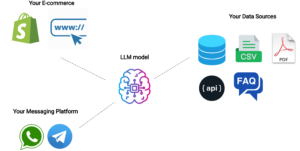
Setting up an AI chatbot for your e-commerce
In the modern e-commerce landscape, the inclusion of an AI chatbot can vastly enhance user experience, operational efficiency, and overall customer satisfaction. If you’re looking to embark on this transformative journey, here’s a step-by-step guide to help you get started.
1. Define Your Goals
Establish what you expect from your chatbot:
- Providing 24/7 customer support?
- Delivering personalized product recommendations?
- Automating routine inquiries like order status checks?
- Gathering insightful customer feedback?
Having distinct objectives will shape the entire integration process.
2. Choose an LLM API Service or Host Your Own LLM Model
Language models, especially large ones (LLM), form the foundation of efficient chatbots. They are the engine that provides reasoning capabilities to your chatbot. You have two main choices:
- Use an LLM API Service: This involves subscribing to a service that offers pre-trained LLMs, like OpenAI’s GPT series. These APIs often provide easy integration, continuous updates, and managed infrastructure.
- Host Your Own LLM Model: If you have specific requirements or data security concerns, you might prefer hosting and managing your own LLM model. This provides greater control but demands more in terms of resources, maintenance, and potential costs.
Make a choice based on your e-commerce platform’s needs, budget, and technical expertise.
3. Design the Chatbot’s Persona
A chatbot isn’t just a tool—it’s an extension of your brand. Ensure it resonates with your brand’s voice and ethos, whether that’s professional, casual, witty, or empathetic. This can done as easily as describing your chatbot personality in a few lines of plain text!
4. Connect Data Sources
Your chatbot’s effectiveness hinges on its access to relevant information. Connecting it to various data sources, such as your e-commerce database or CRM, ensures real-time and accurate responses. You may want to:
- connect the chatbot to the orders database to get information about shipped items,
- check your company guidelines (available as a PDF) for special cases,
- make an API call to get data that is available on a third-party provider,
- …
5. Integration with E-Commerce Platform and Messaging Services
Your chatbot should seamlessly integrate not only with your primary e-commerce platform—like Shopify, WooCommerce, or Magento—but also with popular messaging services such as Telegram and WhatsApp. This multi-platform approach widens your reach, allowing customers to interact with your brand through their preferred platforms. Integrating with these messaging services could involve working with their respective APIs or leveraging middleware solutions to bridge the connections.

Conclusion:
Integrating an AI chatbot into your e-commerce platform might initially appear challenging, but it can be a smooth endeavor with a structured approach and the right tools. As the digital realm evolves, embracing innovations like chatbots positions businesses to offer unparalleled user experiences.
Stay tuned to flair-tech.com for more blog posts about our active projects.
